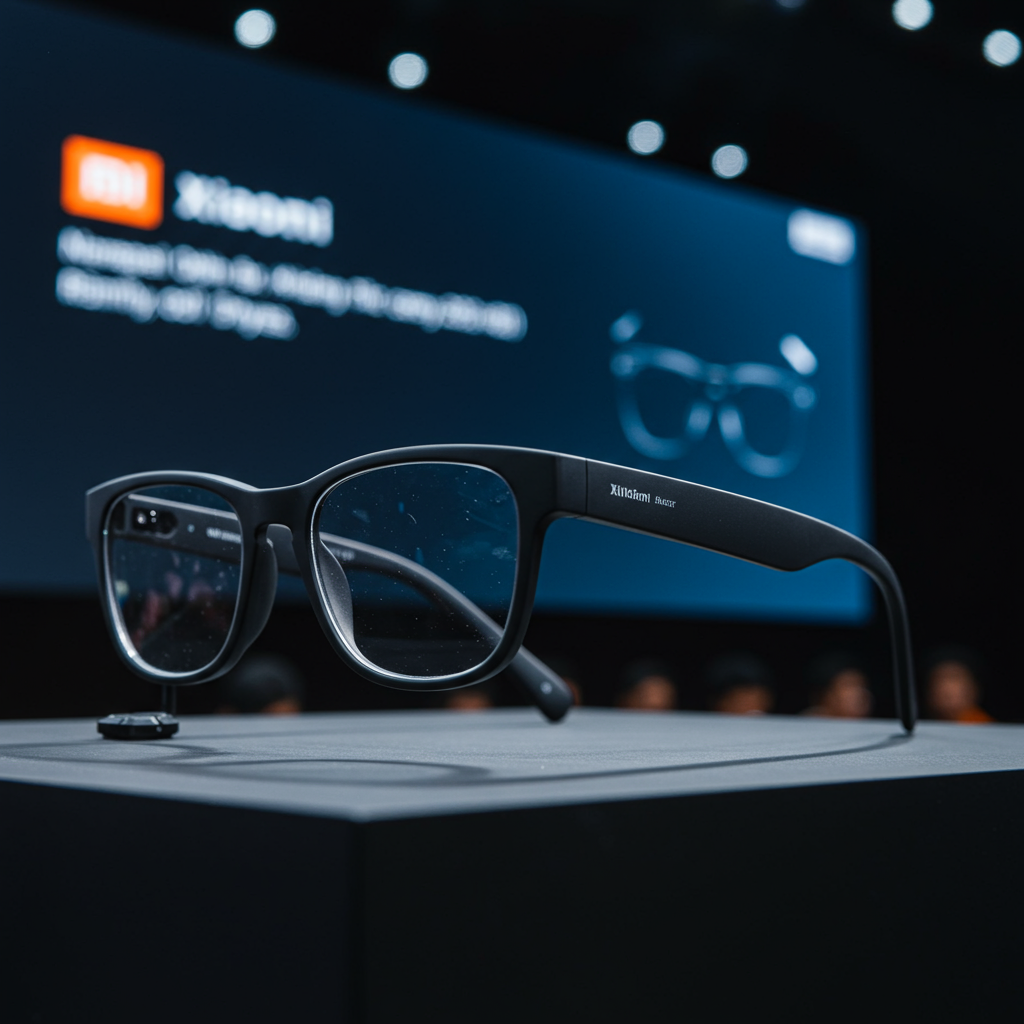Xiaomi, the ambitious Chinese tech giant known for its vast ecosystem spanning smartphones, electric vehicles, and smart home devices, has officially stepped into the competitive arena of smart eyewear. On Thursday, June 26, 2025, the company unveiled its inaugural artificial intelligence (AI)-powered smart glasses. This move signifies Xiaomi’s strategic entry into a rapidly expanding, yet intensely crowded, market segment.
Positioned as a “next-generation personal smart gadget,” these Xiaomi AI glasses aim to blend seamlessly into daily life. They leverage the power of AI and voice interaction to offer a hands-free computing experience. The launch event, themed “Human x Car x Home,” underscored Xiaomi’s vision of integrating technology across various aspects of a user’s world, with these glasses serving as a personal interface. Co-founder and CEO Lei Jun highlighted key features like capturing first-person perspective video and responding to voice commands, functionalities increasingly common in modern smart glasses.
The New Xiaomi AI Glasses: What They Offer
Xiaomi’s entry isn’t just symbolic; they’ve launched a specific product with notable features. These smart glasses are designed to empower users with convenient, on-the-go capabilities powered by artificial intelligence. Their design focuses on integrating tech discreetly into a familiar form factor.
Core AI Capabilities and Interaction
Interaction with the Xiaomi AI glasses is primarily driven by voice commands, facilitated by the company’s built-in XiaoAI assistant. Users can speak requests directly to the frames. This allows for a range of functions without needing to touch a phone. Tasks include taking photos, recording short video clips, and performing real-time object recognition. The AI can also translate text instantly while the user is reading. A highly practical feature enables scanning mobile payment QR codes, allowing for swift transactions.
Camera & Chip Details
The glasses are equipped with a 12-megapixel ultra-wide camera. This camera allows users to capture photos and videos from their natural point of view. Powering the intelligence within the frames is Qualcomm’s AR1 chip. This processor handles the various AI tasks and connectivity features required for smart functionality. The integration of capable hardware is crucial for delivering a responsive and useful wearable AI experience.
Battery Life: A Key Differentiator?
Battery performance is often a critical factor for wearable devices. Xiaomi claims its new AI glasses offer significant endurance. The company stated at the launch event that the frames provide 8.6 hours of battery life on a single charge. Notably, Xiaomi highlighted this as being double the battery life of the popular Ray-Ban Meta smart glasses. Recharging the device from empty to full capacity takes approximately 45 minutes, according to the company. This extended battery life could be a crucial selling point in a market where users desire all-day usability.
Pricing and Availability Context
Xiaomi officially debuted the glasses alongside other new products, including foldable phones and an SUV. The Xiaomi AI glasses have a starting price of 1,999 yuan in China. This converts to approximately US$278.54. This pricing positions the glasses in a mid-range segment compared to some higher-end smart eyewear. However, it was noted by analysts that this price was slightly higher than initial industry expectations, which had predicted a more aggressive sub-1,500 yuan launch to disrupt the market.
Navigating the Crowded Smart Glasses Market
Xiaomi is entering a space that is far from empty. The smart glasses market, particularly in China, is seeing rapid development and increasing competition. Industry observers have described this burgeoning sector as a “war of hundreds of glasses.”
The “War of Hundreds of Glasses”
Market consultancy Counterpoint has indicated that 2025 was anticipated to see a significant influx of new smart glasses products. This projection underpins the description of a widespread competitive battle. While the market is growing, achieving widespread consumer adoption and finding the right product-market fit remains a key challenge for all players involved. Success often depends on finding unique selling propositions and integrating seamlessly into users’ existing tech habits.
Key Competitors and Their Offerings
Meta Platforms, in partnership with Ray-Ban, currently holds a dominant position globally. Counterpoint reported that Meta’s smart glasses accounted for over 60 percent of the global AI glasses market share last year. This establishes a clear market leader that Xiaomi must contend with.
Other notable Chinese players are also vying for market share. Huawei Technologies launched updated AI glasses in April, priced slightly higher at 2,299 yuan (US$320). Huawei’s offering includes AI features like voice commands and real-time translation but notably lacks a camera, differentiating it from Xiaomi and Meta’s camera-equipped models. Baidu also announced its Xiaodu AI glasses late last year, powered by its Ernie AI models and featuring a camera module, with an expected release this year. Firms like Rokid, Thunderbird Innovation, and SHARGE also have existing or planned products in the domestic market, adding to the congestion.
Market Trends and Growth Forecasts
Despite the competitive landscape, the market shows strong growth potential. Counterpoint projected robust expansion for the global smart glasses market. They forecast a 60 percent growth rate in 2025, following a remarkable 210 percent year-on-year surge witnessed in 2024. These figures highlight the rapid trajectory of the sector and the potential rewards for companies that can successfully capture market share. Xiaomi’s entry is timed to capitalize on this upward trend.
Xiaomi’s Strategy: Ecosystem and Market Position
Xiaomi is leveraging its established strengths and a multi-faceted approach to tackle the smart glasses market. Their strategy involves integrating the new eyewear into their broader hardware and software ecosystem.
Leveraging the “Human x Car x Home” Vision
The launch event theme, “Human x Car x Home,” is central to Xiaomi’s long-term strategy. By connecting personal devices like smart glasses with vehicles and smart home products, Xiaomi aims to create a cohesive and convenient user experience. The smart glasses can act as a portable interface within this connected environment. This ecosystem integration is seen by analysts like WellsennXR’s He Wangcheng as a primary strength for Xiaomi compared to many standalone hardware startups.
Is Xiaomi “Testing the Waters”?
The chosen price point of 1,999 yuan sparked debate among industry observers. Given Xiaomi’s history of aggressive pricing to quickly capture market share in other categories, some analysts had expected a lower price. The slightly higher-than-anticipated cost led some to suggest that Xiaomi might be “testing the market” rather than committing to a large-scale, high-cost push to educate consumers and build the category from scratch. Former Meizu executive Li Nan commented that the price might indicate Xiaomi is “not very determined in this area,” viewing it more as an exploratory step. The relatively short presentation time given to the glasses during Xiaomi’s extensive launch event further supported this view for some observers.
Challenges and Adaptations for the Chinese Market
Successfully launching smart glasses in China presents unique hurdles compared to Western markets, largely due to differing consumer habits and physical requirements. Xiaomi appears to have made specific product adjustments to address these local challenges.
Why China is Different from Western Markets
Analysts note significant differences in consumer behavior. While Ray-Ban Meta glasses benefited from being marketed first as stylish sunglasses (fitting Western habits), Chinese consumers less commonly wear sunglasses daily. A large portion of the population wears myopia (nearsightedness) glasses all day. Current smart glasses, including Xiaomi’s, still face challenges with weight and battery life that make them less ideal for constant, all-day wear over prescription lenses compared to standard frames. An 8.6-hour battery life, while improved, is still insufficient for continuous daily use.
Xiaomi’s Product Adjustments
To navigate these specific Chinese market challenges, Xiaomi has implemented product adaptations. One is the use of a dual-chip solution, combining the main Qualcomm AR1 chip with a low-power secondary chip. This architecture helps manage different tasks efficiently, contributing to the extended battery life. Another adaptation is the planned launch of an electrochromic version of the glasses. This variant can function like sunglasses, catering to specific scenarios and usage occasions where battery life demands are lower and sun protection is relevant. These tailored features aim to improve user experience within the unique Chinese context.
Industry Reactions and Future Outlook
Xiaomi’s entry has elicited a mixed response from the smart glasses industry in China. There is both hope for market growth and concern over potential competition.
Competitor Concerns vs. Market Hopes
On one hand, the industry harbors hope that Xiaomi’s strong brand recognition, vast user base, and extensive resources could help “educate users” about the value of smart glasses. This could potentially “activate the market” and drive overall industry development, benefiting all players. On the other hand, competitors are wary of Xiaomi’s historical tendency for aggressive pricing supported by a robust supply chain, fearing it could limit opportunities for smaller firms. The 1,999 yuan price, while higher than expected, was seen as a relief by some, suggesting a certain level of profitability might still be possible.
The Path to Product Market Fit in China
Ultimately, the success of Xiaomi’s AI glasses, and the broader smart glasses category in China, depends on finding the crucial Product Market Fit (PMF). This involves developing a product that truly meets the needs and habits of Chinese consumers at a viable price point. Xiaomi’s relatively conservative initial sales expectation (reportedly aiming for “over 300,000 units” for the first generation, compared to Meta’s 1 million+ sales) suggests an acknowledgment of the market’s current “unadapted” nature. Whether Xiaomi’s specific adaptations resonate with users and if the industry as a whole can overcome challenges like weight, battery life, and integrating with prescription lenses will determine the pace of adoption.
Frequently Asked Questions
What specific AI capabilities do Xiaomi’s new smart glasses offer?
Xiaomi’s AI glasses, powered by the XiaoAI assistant, enable hands-free interaction via voice commands. Key functions include taking photos and videos, recognizing objects in the user’s view, translating text while reading, and scanning mobile payment QR codes for quick transactions.
How does the price and battery life of Xiaomi’s AI glasses compare to competitors?
Xiaomi’s AI glasses start at 1,999 yuan (approx. US$278.54). The company claims a battery life of 8.6 hours, which is stated to be double that of the Ray-Ban Meta glasses. Huawei’s recent AI glasses, by comparison, are priced slightly higher at 2,299 yuan and lack a camera.
What is Xiaomi’s strategy for entering the crowded AI glasses market in China?
Xiaomi plans to leverage its extensive “Human x Car x Home” ecosystem to integrate the glasses into users’ existing tech lives. While some see the 1,999 yuan price as potentially “testing the waters” rather than a full aggressive push, Xiaomi has also developed market-specific adaptations like a dual-chip solution for better battery life and planning an electrochromic (sunglass) version.
Conclusion
Xiaomi’s launch of its first AI-powered smart glasses marks a significant step into the competitive wearable technology market. Featuring a camera, voice-controlled AI capabilities, and promising battery life, these glasses are positioned to integrate within Xiaomi’s broad ecosystem. While entering a crowded field dominated by players like Meta and facing unique challenges in the Chinese market related to consumer habits and form factor, Xiaomi’s strategic adaptations and brand strength offer potential. The success of these Xiaomi AI glasses will provide valuable insight into the future trajectory of wearable AI and the ongoing “war of hundreds of glasses” in the global tech landscape.



